This is the USDA’s procedure for home canning plain tomato sauce.
The tomato sauce meant here is pure, unadulterated tomato sauce, with no other vegetable, no meat, no fish or no seafood added to it. It would be unsafe to do so with this procedure below.
If you want a sauce with added items, browse this site for other tested tomato sauce recipes that call for various added items.
Even if you do can some fancier sauces, you will probably always still want plain tomato sauce to hand, because it allows for maximum versatility when you go to use it.
See also: Tomato sauce in 1.5 litre (quart) jars .
Quantities of fresh tomatoes needed
Numbers are approximate guidelines. Results will vary by variety of tomato used, etc.
Thin tomato sauce
On average, as a very rough guideline, expect to need about 2 kg (5 lbs) of tomatoes per litre (US quart) of thin tomato sauce you make.
- 16 kg (35 lb) of tomatoes = 7 litres (US quarts) thin tomato sauce
- 10 kg (21 lbs ) of tomatoes = 9 x half-litres (US pints) thin tomato sauce
- 1 US bushel tomatoes = 24 kg (53 lbs) = 10 to 12 litres (US quarts) thin tomato sauce
Thick tomato sauce
On average, as a very rough guideline, expect to need about 3 kg (6.5 lbs) of tomatoes per litre (US quart) of thick tomato sauce you make.
- 20 kg (46 lb) of tomatoes = 7 litres (US quarts) thick tomato sauce
- 12 kg (28 lbs ) of tomatoes = 9 x half-litres (US pints) thick tomato sauce
- 1 US bushel tomatoes = 24 kg (53 lbs) = 7 to 9 litres (US quarts) thick tomato sauce
The Recipe
Jar size choices: Either half-litre (1 US pint) OR 1 litre (1 US quart)
Processing method: Water-bath canner OR steam canning
Yield: varies
Headspace: 2 cm ( ½ inch) (See Headspace* note below)
Processing time: Half-litres (pints) 35 minutes; litres (quarts) 40 minutes.
The USDA also offers a pressure canning process. See here for pressure-canning tomato sauce time and pressures.
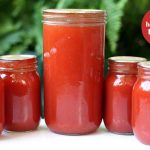
Tomato Sauce
Ingredients
- tomatoes
- lemon juice (bottled. OR citric acid)
- salt (optional)
Instructions
- Wash tomatoes.
- Stem them, and trim off and discard bruises. Don't peel or seed.
- Take 6 of the tomatoes, cut into quarters and add to a large pot over high heat.
- Crush them with a potato masher or other similar tool.
- Stirring the pot frequently and keeping the heat high, continue to quarter the remaining tomatoes, adding them as you do and crushing them, so that they heat rapidly, too, and the mixture keeps on boiling, uncovered.
- When all the tomato is in, let simmer strongly for another 5 minutes.
- Pass tomato mixture through a sieve or food mill to remove skin and seeds.
- Put juice back in pot, bring back to a boil, then lower to a simmer.
- Simmer sauce until sauce reaches desired consistency.
- MANDATORY. Acidify jars.
- To each half-litre/ pint jar add either 1 tablespoon bottled lemon juice OR ¼ teaspoon citric acid.
- To each litre/quart jar add either 2 tablespoons bottled lemon juice OR ½ teaspoon citric acid.
- OPTIONAL: ½ teaspoon salt per half-litre/ pint; 1 teaspoon per litre/quart jar.
- Ladle hot juice into jars.
- Leave 2 cm (½ inch) headspace.
- Wipe jar rims.
- Put lids on.
- Process in a water bath or steam canner.
- Process half-litres/pints for 35 minutes; litre (quart) jars for 40 minutes. Increase time as needed for your altitude.
Nutrition
Reference information
How to water bath process.
How to steam can.
When water-bath canning or steam canning, you must adjust the pressure for your altitude.
More information about canning tomatoes in general.
How to pressure can.
When pressure canning, you must adjust the pressure for your altitude.
Recipe notes
You may, should you choose, safely add dry seasoning in the form of dried (not fresh) herbs, salt or sugar.
Instead of salt, you can use a non-bitter, non-clouding salt sub. We have found Herbamare Sodium-Free performs well in that regard.
Generally, paste-type tomatoes such as Roma, San Marzano, Amish Paste, “plum” tomatoes, etc, are recommended for sauce as they have less water to be boiled off. Some people argue, though, that adding some “watery” aka “slicing” tomatoes such as beefsteak helps to brighten and sweeten the taste.
The hardest part of all this is the straining. If you do it every year, eventually you will want to go shopping for a food mill to save you a great deal of time, reduce wastage and increase yield.
The tomatoes must be peeled; you can’t just grind them in with a blender. This is a safety issue. A great deal of the bacteria is on the skin. The processing times were developed on the understanding that you have done your part in following directions, and reducing the bacterial load going into the canner by removing the peel. All new processing times would need to be developed for leaving the skin on and there is currently no funding for that.
There’s an enzyme (“Pectinesterorse”) in tomatoes which activates when tomatoes are crushed, but which can be neutralized by high heat. It causes tomato juices and sauces to separate into thick parts and watery parts. Dealing with this enzyme is the reason for heating some tomato pieces first, then adding other pieces slowly: to kill the enzyme before it can kick into action and give you a watery tomato product. For more information see here.
Filled jars must also be heat processed: you have your choice of water-bath processing, steam canner processing, or pressure-canning with this reicp . All methods are equivalents and no method is safer than the other. The heat processing deals with nasties that don’t mind the acidity: such as listeria, salmonella, moulds, etc.
All home-canned tomato sauce must be acidified or it’s not safe for consumption. The added acidity ensures a pH below 4.6, which prevents botulism spores from germinating.
Quarter-litre (½ US pint) jars can be very useful for recipes that call for 1 cup (250 ml / 8 oz) of tomato sauce, so that you aren’t opening a larger jar than needed.
The USDA doesn’t give directions specifically for that size, so you must acidify them and process them as per the larger size of half-litre (1 US pint.)
Reducing the tomato sauce to desired consistency
You need to reduce the tomato volume by one-third for thin sauce; one-half for thick sauce.
Be prepared for this to take hours. If your cooking fuel is electric and you have time-of-use rates, you will want to do this at cheap rate times.
The wider the mouth on your pot, the better evaporation rate you will get.
Some people suggest dividing the tomato between two or more pots to improve the boil down rate. Others suggest baking it in large roasting pans in the oven. Some suggest skimming off portions of the liquid, and zapping it in microwave for 20 minutes uncovered to reduce by half, then adding that back to mixture.
Some people boil their tomatoes down outside over propane burners.
Whatever you do, expect this to take 2 to 3 hours at a minimum, and far longer for large quantities of watery tomatoes.
Headspace*
There isn’t agreement over how much headspace is best, so you will need to see what you have the best luck with over time:
- 1 cm (¼ inch) headspace is called for by the USDA. [1] United States Department of Agriculture (USDA). Complete guide to home canning. Agriculture information bulletin No. 539. 2015. Page 3-8
- 2 cm (½ inch ) is called for by Presto [2] Presto Pressure Canner and Cooker, 23 quart model, #72-719F. 2014. p 32 and Ball [3] Ball Blue Book Guide to Preserving. Daleville, Indiana: Hearthmark LLC. Edition 36. 2013. Page 23.
We use the 2 cm (½ inch) headspace. If you are pressure canning, you’ll definitely want that, if not a tidge more.
Source
Standard tomato sauce. United States Department of Agriculture (USDA). Complete guide to home canning. Agriculture information bulletin No. 539. 2015. Page 3-8.
Nutrition
Further Reading
General information on canning tomatoes.
Acidification of tomato products: United States Department of Agriculture (USDA). Complete guide to home canning. Agriculture information bulletin No. 539. 2015. Page 3-5.
Cooking with canning
References

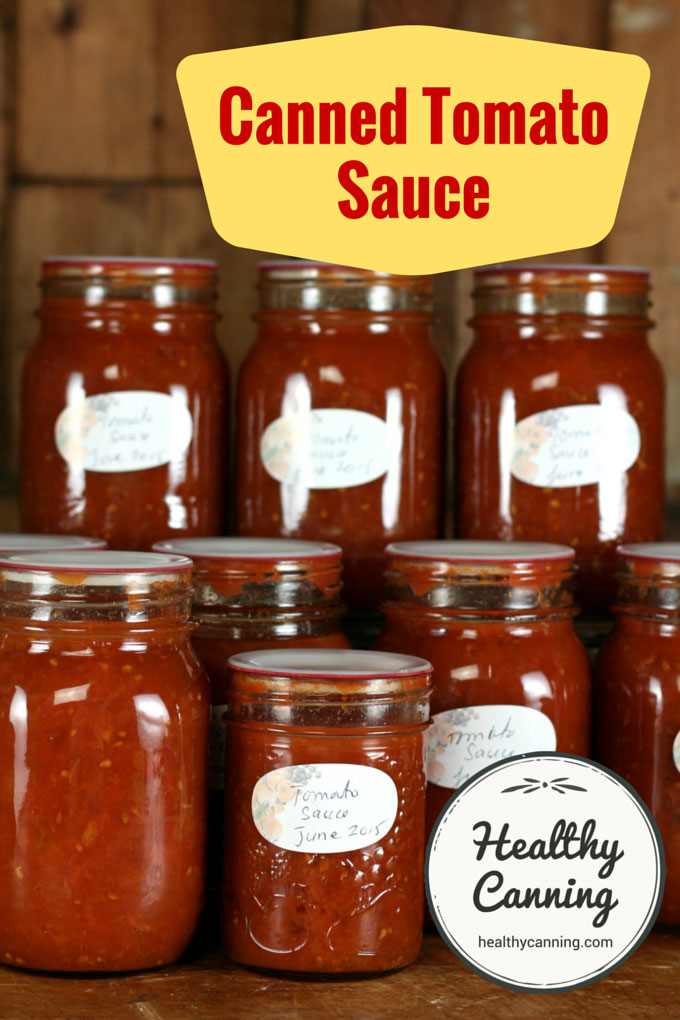
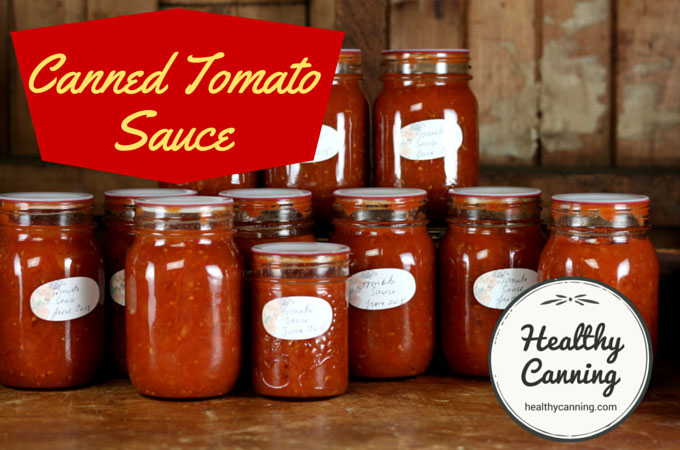
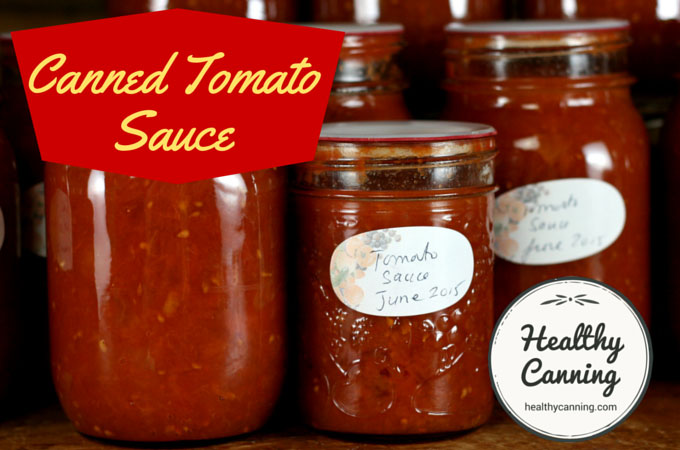
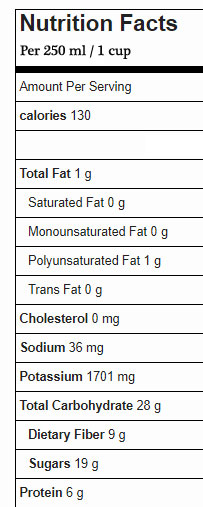



Kristen Kelly
I time shift canning my tomatoes. I freeze them till I have time. It’s colder out and the added heat to the house is wanted. Freezing them breaks down the cell walls so when I defrost them or microwave them for a short time till just softened. I core them and microwave more. The bowl the tomatoes are in will have the defrosted water. This can reduce cooking time with a large batch by hours.
Kim Hurren
I sure hope that you are including that tomato “water” in your sauce. The recipes do not indicate draining the tomatoes as it can impact acidity
Brittany
Is garlic powder considered an herb when adding seasonings to this recipie?
Healthy Canning
See safe tweaking: https://www.healthycanning.com/safe-tweaking-of-home-canning-recipes/
Lynn
When canning tomato sauce, can cooked meat be added to the sauce before canning?
Healthy Canning
No. Upon opening the jar to use, add whatever you wish.